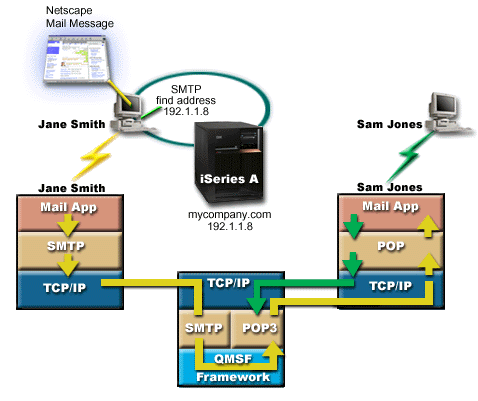This example demonstrates how e-mail is processed between local users.
Situation
Jane Smith, the Human Resources director, needs to send a message to Sam Jones in the Legal department. They both work at MyCompany headquarters. By following this process, you will be able to see how e-mail is handled on your iSeries™ server.
The objectives of this example are as follows:
- Demonstrate how e-mail clients and servers relate to each other, and how a message is processed
- Use the SMTP server to send mail
- Deliver mail to a POP user
Details
The following image depicts the network for MyCompany and how a mail message passes through the various layers in order to get to its final destination. After the image, you will find a step-by-step description of the path the mail message takes through this network.

Jane is using the Netscape mail client. She writes a message and sends it to SamJones@mycompany.com.
Phase 1: SMTP client to SMTP server
The SMTP client on Jane's PC uses the configuration data that was entered for the outgoing server and identity. The identity field is used for the From address. The outgoing server is the host that is contacted by the PC SMTP client. Because the address is entered as a domain, the SMTP client queries Domain Name System (DNS) to get the IP address of the SMTP server, and discovers that it is 192.1.1.8.
The SMTP client now contacts the SMTP server on the SMTP port (Port 25 at 192.1.8). The dialog that is used between the client and the server is the SMTP protocol. The SMTP server accepts the delivery of the mail, and the message is transmitted from the client to the server using TCP/IP.
Phase 2: SMTP server delivers the message to the POP server
The SMTP server tests the domain of the recipient to see if it is local. Because it is local, the mail is written out to an IFS file and the QMSF Framework Create Message application programming interface (API) is used to put the message information in the QMSF queue. The QMSF framework allows the distribution of e-mail, calling exit programs or snap-ins to handle specific mail types. The message information identifies Sam's address as SMTP format, so the framework calls the SMTP Address Resolution exit program. This program again checks that the message is local. Because it is local, it uses the system distribution directory (data entered through WRKDIRE) to find the recipient's SMTP address. It finds Sam's address, and finds the mail service level is system message store in the directory entry for this user, therefore it recognizes it as a POP account. Then SMTP Address Resolution adds his profile information to the message information. It marks the information as POP local delivery. The QMSF Framework then calls the POP Local Delivery exit program, which finds the profile information and the name of the IFS file and delivers the mail to Sam's mailbox.
Phase 3: POP Client retrieves message for Sam Jones from the POP server
Some time later, Sam decides to use his mail client (Netscape) to check his mailbox for e-mails. The POP client on his PC is configured to check the POP server at mycompany.com for the user name SamJones and password (******). The domain name is again changed to an IP address (using DNS). The POP client contacts the POP server using the POP port and the POP3 protocol. The mailbox user name and password are used by the POP server on the iSeries to check that the user name and password match the profile and password of an iSeries user. After it is validated, the profile name is used to find Sam's mailbox. The POP client loads the message, and sends a request back to the POP server to delete the mail from the POP mailbox. The message is then displayed in Netscape for Sam to read.